International Marketing Plan: Sodashi's Entry into Singapore Market
VerifiedAdded on 2021/06/17
|23
|5139
|59
Report
AI Summary
This report presents a comprehensive marketing plan for Sodashi, a skincare brand, aiming to enter the Singapore market. The plan begins with an introduction and objectives, followed by a detailed market environment analysis using the PESTLE framework, examining political, economic, social, technological, legal, and environmental factors. A competitor analysis employing Porter's Five Forces model identifies industry rivalry, the threat of new entrants and substitutes, and the bargaining power of suppliers and customers. The report assesses market readiness through a SWOT analysis, highlighting Sodashi's strengths, weaknesses, opportunities, and threats. It recommends Foreign Direct Investment (FDI) as the mode of entry and outlines an STP (Segmentation, Targeting, Positioning) strategy. The marketing mix elements, including product, price, promotion, and distribution strategies, are also discussed. The report concludes with a summary of key findings and recommendations for Sodashi's successful entry into the Singapore market.
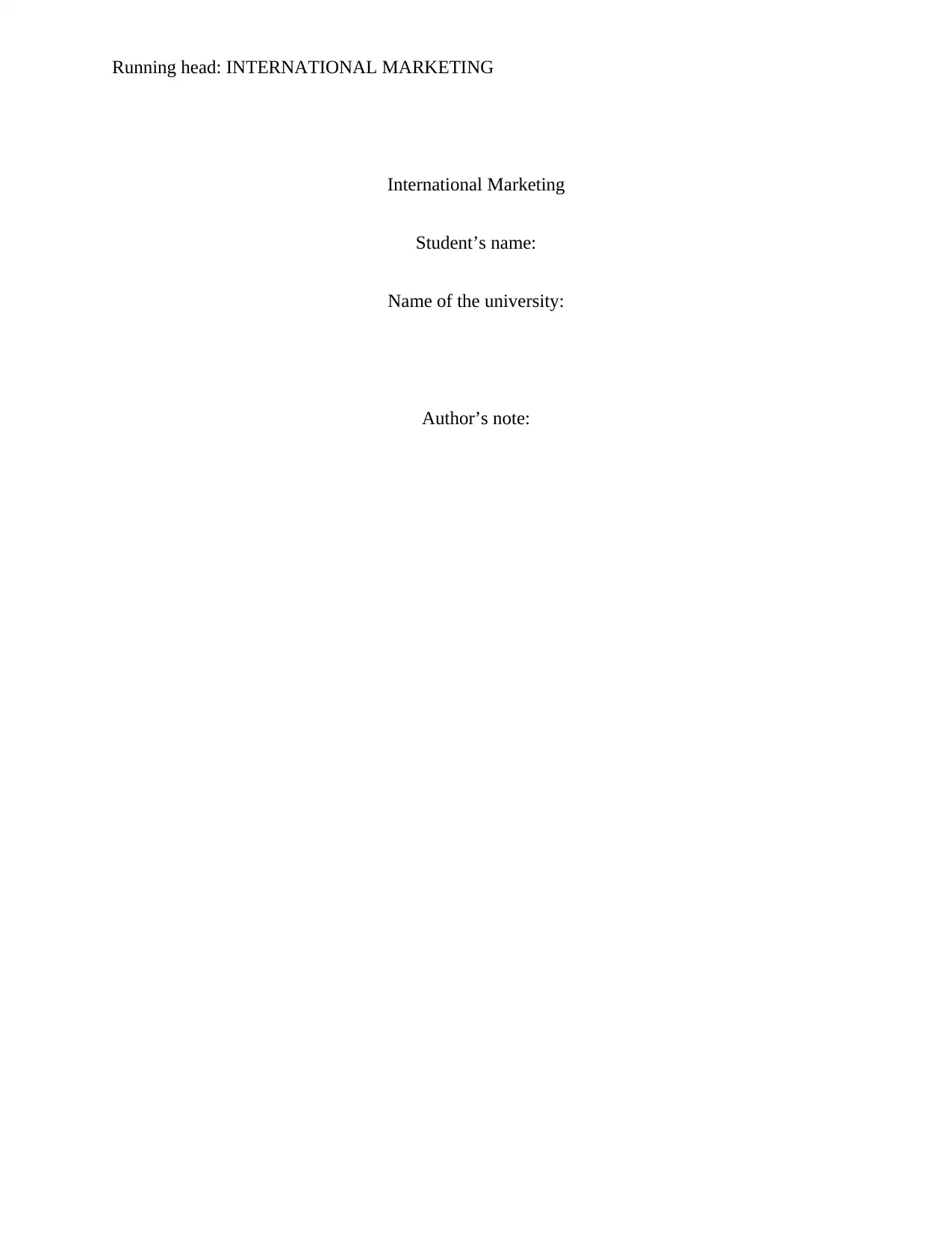
Running head: INTERNATIONAL MARKETING
International Marketing
Student’s name:
Name of the university:
Author’s note:
International Marketing
Student’s name:
Name of the university:
Author’s note:
Paraphrase This Document
Need a fresh take? Get an instant paraphrase of this document with our AI Paraphraser
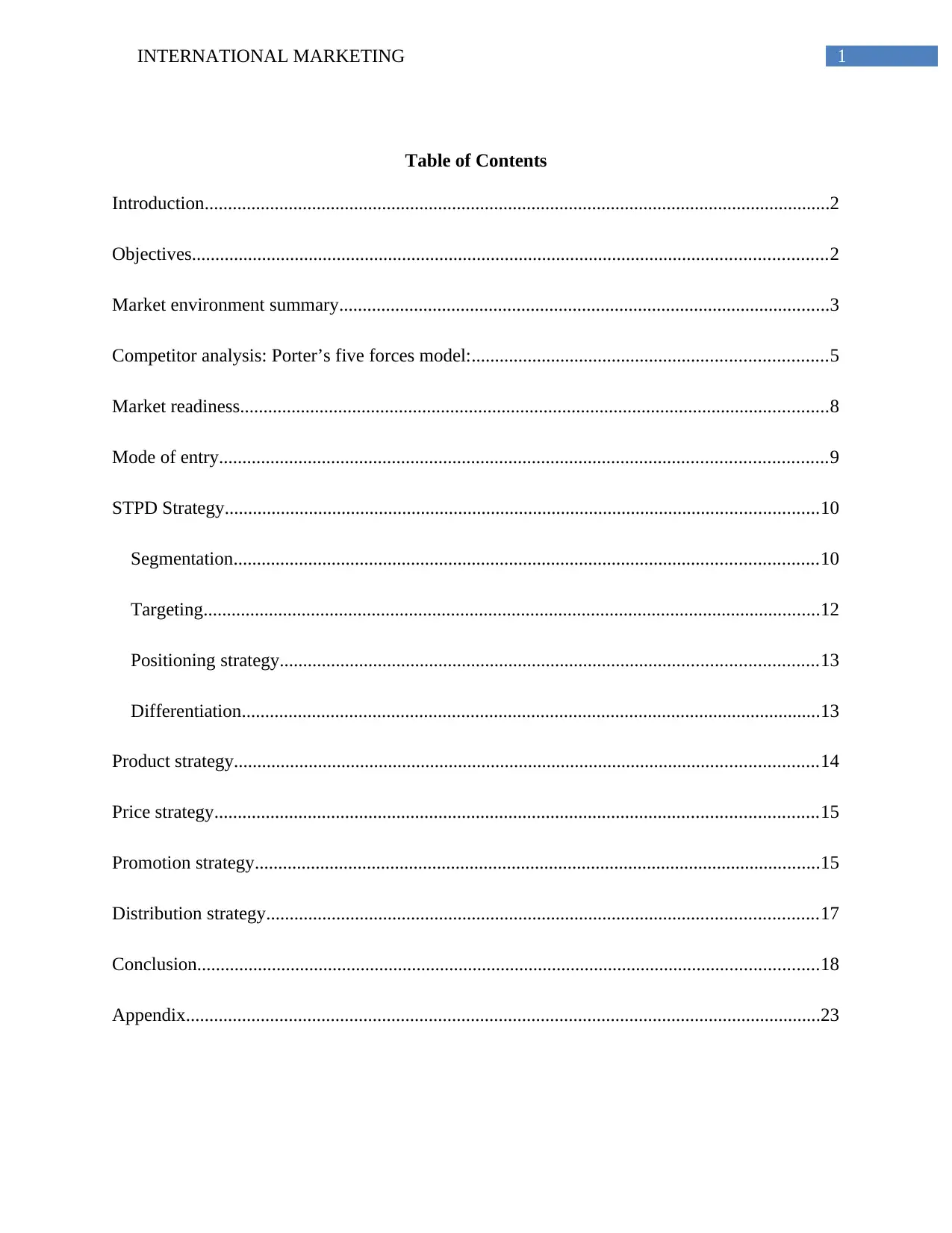
1INTERNATIONAL MARKETING
Table of Contents
Introduction......................................................................................................................................2
Objectives........................................................................................................................................2
Market environment summary.........................................................................................................3
Competitor analysis: Porter’s five forces model:............................................................................5
Market readiness..............................................................................................................................8
Mode of entry..................................................................................................................................9
STPD Strategy...............................................................................................................................10
Segmentation.............................................................................................................................10
Targeting....................................................................................................................................12
Positioning strategy...................................................................................................................13
Differentiation............................................................................................................................13
Product strategy.............................................................................................................................14
Price strategy.................................................................................................................................15
Promotion strategy.........................................................................................................................15
Distribution strategy......................................................................................................................17
Conclusion.....................................................................................................................................18
Appendix........................................................................................................................................23
Table of Contents
Introduction......................................................................................................................................2
Objectives........................................................................................................................................2
Market environment summary.........................................................................................................3
Competitor analysis: Porter’s five forces model:............................................................................5
Market readiness..............................................................................................................................8
Mode of entry..................................................................................................................................9
STPD Strategy...............................................................................................................................10
Segmentation.............................................................................................................................10
Targeting....................................................................................................................................12
Positioning strategy...................................................................................................................13
Differentiation............................................................................................................................13
Product strategy.............................................................................................................................14
Price strategy.................................................................................................................................15
Promotion strategy.........................................................................................................................15
Distribution strategy......................................................................................................................17
Conclusion.....................................................................................................................................18
Appendix........................................................................................................................................23
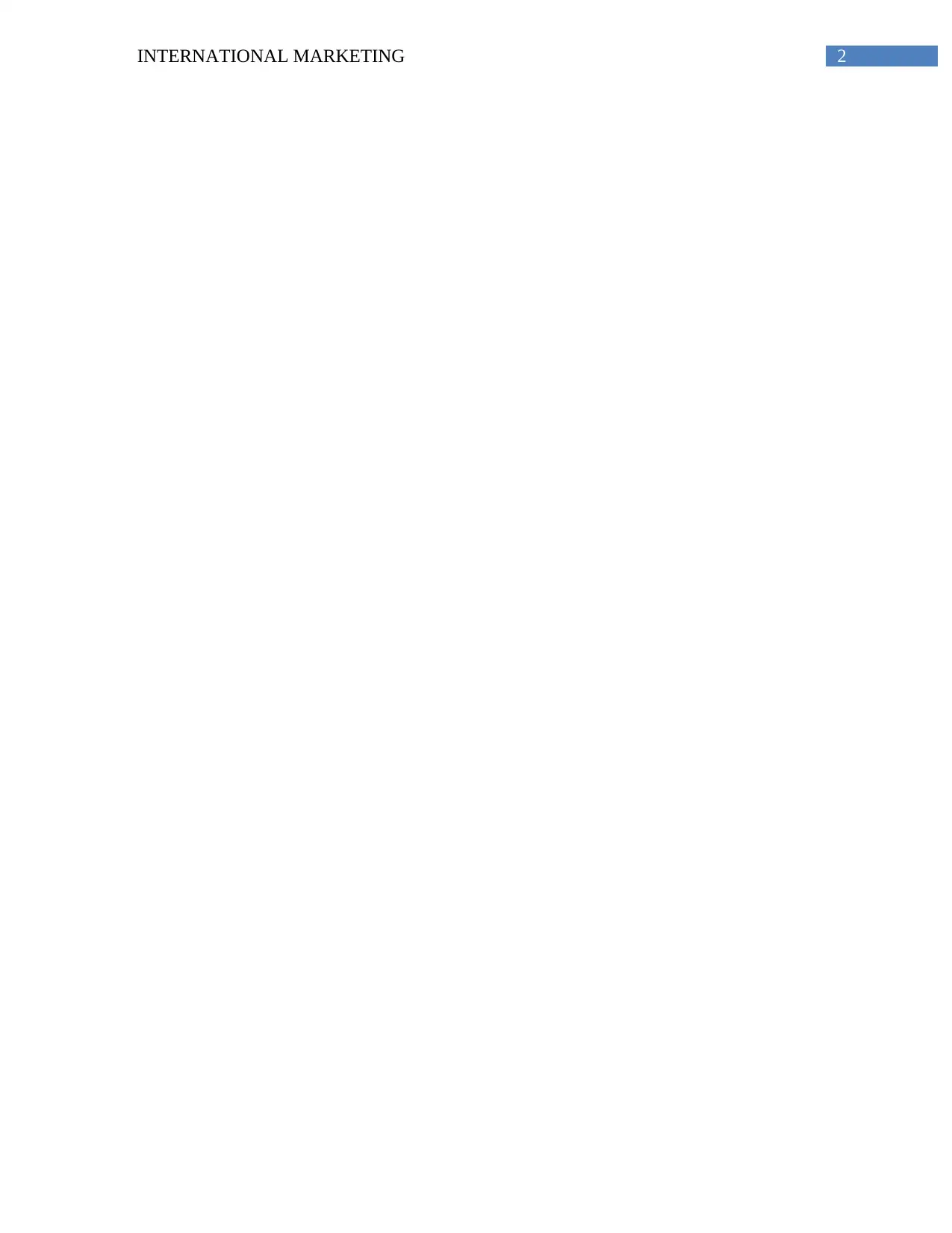
2INTERNATIONAL MARKETING
⊘ This is a preview!⊘
Do you want full access?
Subscribe today to unlock all pages.

Trusted by 1+ million students worldwide
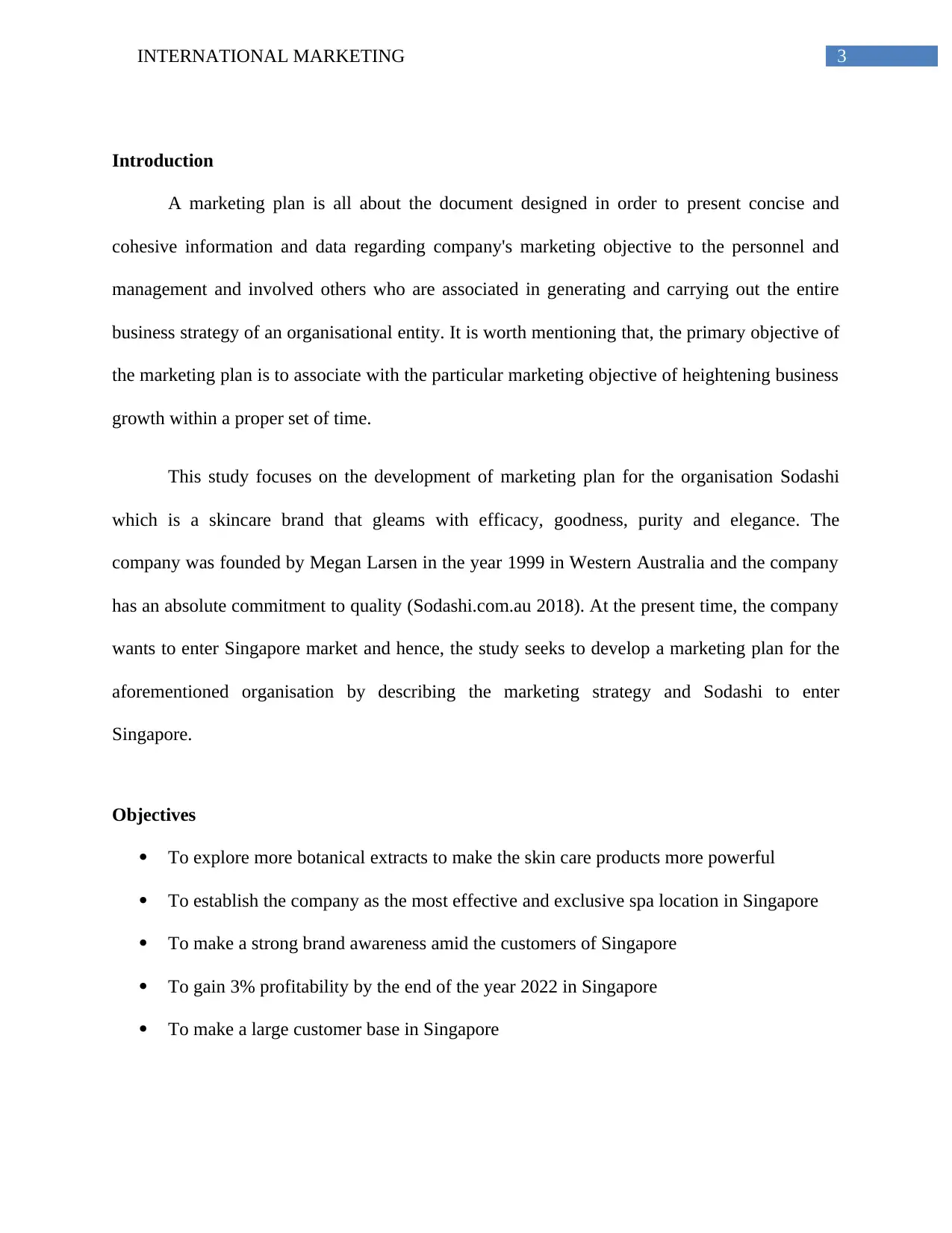
3INTERNATIONAL MARKETING
Introduction
A marketing plan is all about the document designed in order to present concise and
cohesive information and data regarding company's marketing objective to the personnel and
management and involved others who are associated in generating and carrying out the entire
business strategy of an organisational entity. It is worth mentioning that, the primary objective of
the marketing plan is to associate with the particular marketing objective of heightening business
growth within a proper set of time.
This study focuses on the development of marketing plan for the organisation Sodashi
which is a skincare brand that gleams with efficacy, goodness, purity and elegance. The
company was founded by Megan Larsen in the year 1999 in Western Australia and the company
has an absolute commitment to quality (Sodashi.com.au 2018). At the present time, the company
wants to enter Singapore market and hence, the study seeks to develop a marketing plan for the
aforementioned organisation by describing the marketing strategy and Sodashi to enter
Singapore.
Objectives
To explore more botanical extracts to make the skin care products more powerful
To establish the company as the most effective and exclusive spa location in Singapore
To make a strong brand awareness amid the customers of Singapore
To gain 3% profitability by the end of the year 2022 in Singapore
To make a large customer base in Singapore
Introduction
A marketing plan is all about the document designed in order to present concise and
cohesive information and data regarding company's marketing objective to the personnel and
management and involved others who are associated in generating and carrying out the entire
business strategy of an organisational entity. It is worth mentioning that, the primary objective of
the marketing plan is to associate with the particular marketing objective of heightening business
growth within a proper set of time.
This study focuses on the development of marketing plan for the organisation Sodashi
which is a skincare brand that gleams with efficacy, goodness, purity and elegance. The
company was founded by Megan Larsen in the year 1999 in Western Australia and the company
has an absolute commitment to quality (Sodashi.com.au 2018). At the present time, the company
wants to enter Singapore market and hence, the study seeks to develop a marketing plan for the
aforementioned organisation by describing the marketing strategy and Sodashi to enter
Singapore.
Objectives
To explore more botanical extracts to make the skin care products more powerful
To establish the company as the most effective and exclusive spa location in Singapore
To make a strong brand awareness amid the customers of Singapore
To gain 3% profitability by the end of the year 2022 in Singapore
To make a large customer base in Singapore
Paraphrase This Document
Need a fresh take? Get an instant paraphrase of this document with our AI Paraphraser
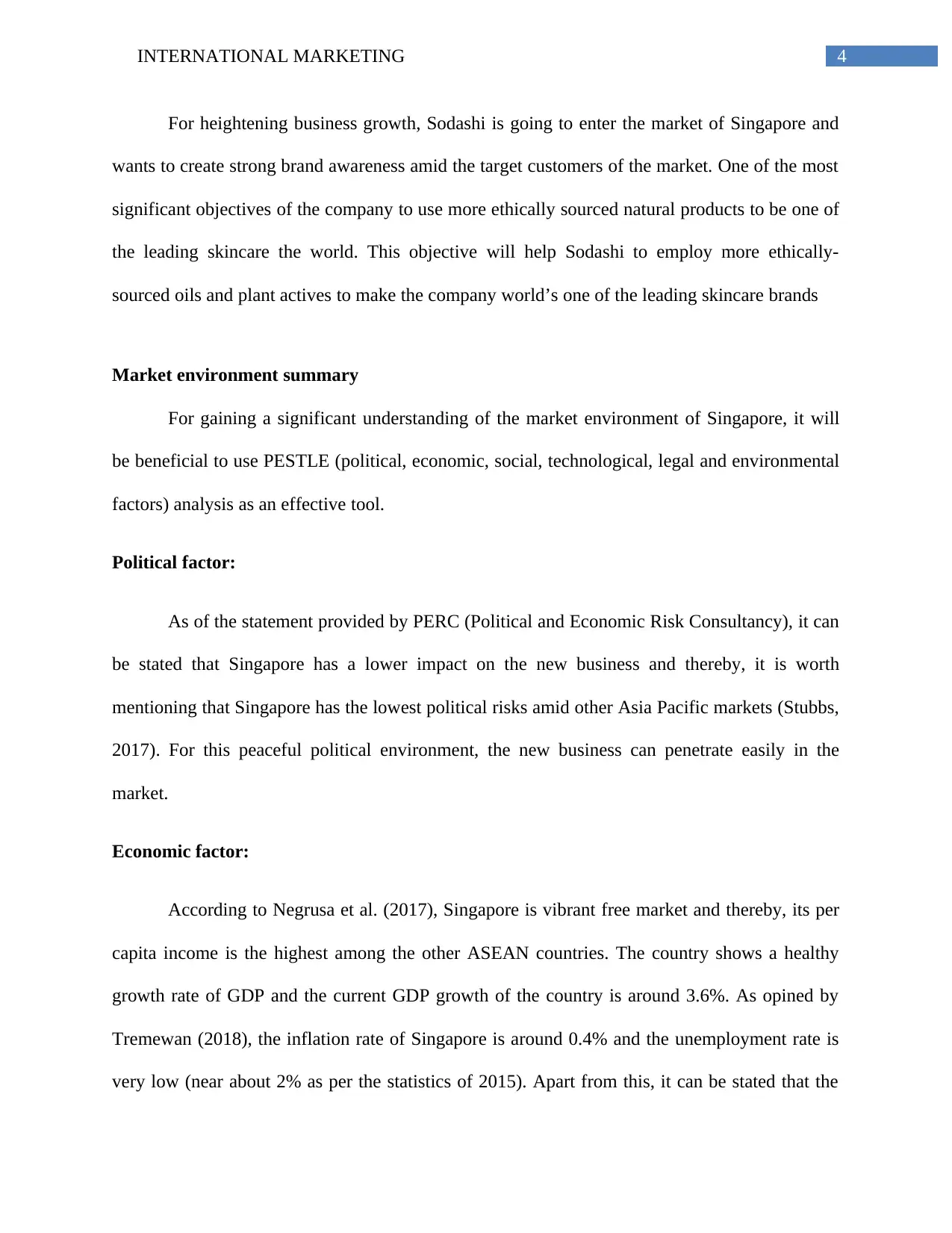
4INTERNATIONAL MARKETING
For heightening business growth, Sodashi is going to enter the market of Singapore and
wants to create strong brand awareness amid the target customers of the market. One of the most
significant objectives of the company to use more ethically sourced natural products to be one of
the leading skincare the world. This objective will help Sodashi to employ more ethically-
sourced oils and plant actives to make the company world’s one of the leading skincare brands
Market environment summary
For gaining a significant understanding of the market environment of Singapore, it will
be beneficial to use PESTLE (political, economic, social, technological, legal and environmental
factors) analysis as an effective tool.
Political factor:
As of the statement provided by PERC (Political and Economic Risk Consultancy), it can
be stated that Singapore has a lower impact on the new business and thereby, it is worth
mentioning that Singapore has the lowest political risks amid other Asia Pacific markets (Stubbs,
2017). For this peaceful political environment, the new business can penetrate easily in the
market.
Economic factor:
According to Negrusa et al. (2017), Singapore is vibrant free market and thereby, its per
capita income is the highest among the other ASEAN countries. The country shows a healthy
growth rate of GDP and the current GDP growth of the country is around 3.6%. As opined by
Tremewan (2018), the inflation rate of Singapore is around 0.4% and the unemployment rate is
very low (near about 2% as per the statistics of 2015). Apart from this, it can be stated that the
For heightening business growth, Sodashi is going to enter the market of Singapore and
wants to create strong brand awareness amid the target customers of the market. One of the most
significant objectives of the company to use more ethically sourced natural products to be one of
the leading skincare the world. This objective will help Sodashi to employ more ethically-
sourced oils and plant actives to make the company world’s one of the leading skincare brands
Market environment summary
For gaining a significant understanding of the market environment of Singapore, it will
be beneficial to use PESTLE (political, economic, social, technological, legal and environmental
factors) analysis as an effective tool.
Political factor:
As of the statement provided by PERC (Political and Economic Risk Consultancy), it can
be stated that Singapore has a lower impact on the new business and thereby, it is worth
mentioning that Singapore has the lowest political risks amid other Asia Pacific markets (Stubbs,
2017). For this peaceful political environment, the new business can penetrate easily in the
market.
Economic factor:
According to Negrusa et al. (2017), Singapore is vibrant free market and thereby, its per
capita income is the highest among the other ASEAN countries. The country shows a healthy
growth rate of GDP and the current GDP growth of the country is around 3.6%. As opined by
Tremewan (2018), the inflation rate of Singapore is around 0.4% and the unemployment rate is
very low (near about 2% as per the statistics of 2015). Apart from this, it can be stated that the
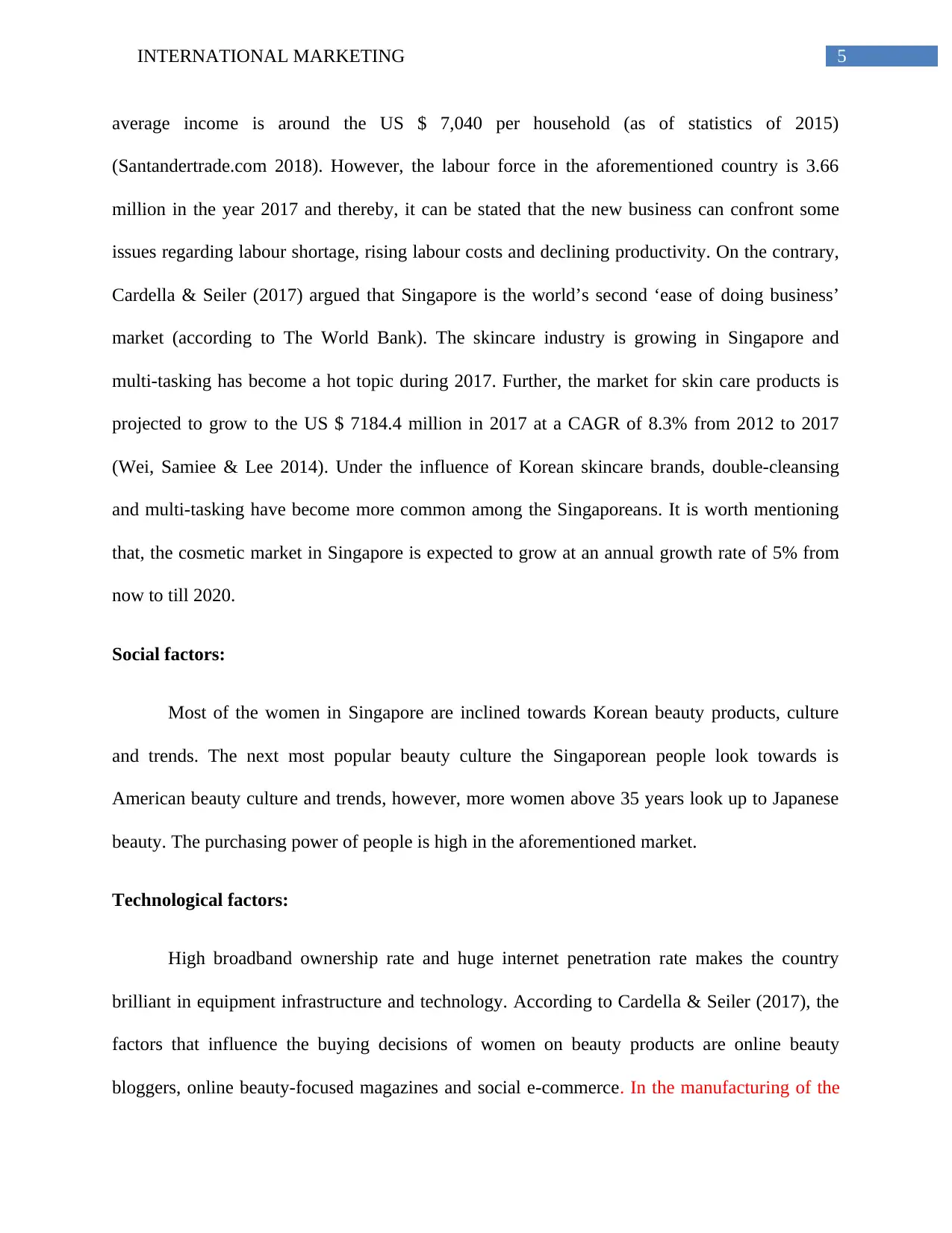
5INTERNATIONAL MARKETING
average income is around the US $ 7,040 per household (as of statistics of 2015)
(Santandertrade.com 2018). However, the labour force in the aforementioned country is 3.66
million in the year 2017 and thereby, it can be stated that the new business can confront some
issues regarding labour shortage, rising labour costs and declining productivity. On the contrary,
Cardella & Seiler (2017) argued that Singapore is the world’s second ‘ease of doing business’
market (according to The World Bank). The skincare industry is growing in Singapore and
multi-tasking has become a hot topic during 2017. Further, the market for skin care products is
projected to grow to the US $ 7184.4 million in 2017 at a CAGR of 8.3% from 2012 to 2017
(Wei, Samiee & Lee 2014). Under the influence of Korean skincare brands, double-cleansing
and multi-tasking have become more common among the Singaporeans. It is worth mentioning
that, the cosmetic market in Singapore is expected to grow at an annual growth rate of 5% from
now to till 2020.
Social factors:
Most of the women in Singapore are inclined towards Korean beauty products, culture
and trends. The next most popular beauty culture the Singaporean people look towards is
American beauty culture and trends, however, more women above 35 years look up to Japanese
beauty. The purchasing power of people is high in the aforementioned market.
Technological factors:
High broadband ownership rate and huge internet penetration rate makes the country
brilliant in equipment infrastructure and technology. According to Cardella & Seiler (2017), the
factors that influence the buying decisions of women on beauty products are online beauty
bloggers, online beauty-focused magazines and social e-commerce. In the manufacturing of the
average income is around the US $ 7,040 per household (as of statistics of 2015)
(Santandertrade.com 2018). However, the labour force in the aforementioned country is 3.66
million in the year 2017 and thereby, it can be stated that the new business can confront some
issues regarding labour shortage, rising labour costs and declining productivity. On the contrary,
Cardella & Seiler (2017) argued that Singapore is the world’s second ‘ease of doing business’
market (according to The World Bank). The skincare industry is growing in Singapore and
multi-tasking has become a hot topic during 2017. Further, the market for skin care products is
projected to grow to the US $ 7184.4 million in 2017 at a CAGR of 8.3% from 2012 to 2017
(Wei, Samiee & Lee 2014). Under the influence of Korean skincare brands, double-cleansing
and multi-tasking have become more common among the Singaporeans. It is worth mentioning
that, the cosmetic market in Singapore is expected to grow at an annual growth rate of 5% from
now to till 2020.
Social factors:
Most of the women in Singapore are inclined towards Korean beauty products, culture
and trends. The next most popular beauty culture the Singaporean people look towards is
American beauty culture and trends, however, more women above 35 years look up to Japanese
beauty. The purchasing power of people is high in the aforementioned market.
Technological factors:
High broadband ownership rate and huge internet penetration rate makes the country
brilliant in equipment infrastructure and technology. According to Cardella & Seiler (2017), the
factors that influence the buying decisions of women on beauty products are online beauty
bloggers, online beauty-focused magazines and social e-commerce. In the manufacturing of the
⊘ This is a preview!⊘
Do you want full access?
Subscribe today to unlock all pages.

Trusted by 1+ million students worldwide
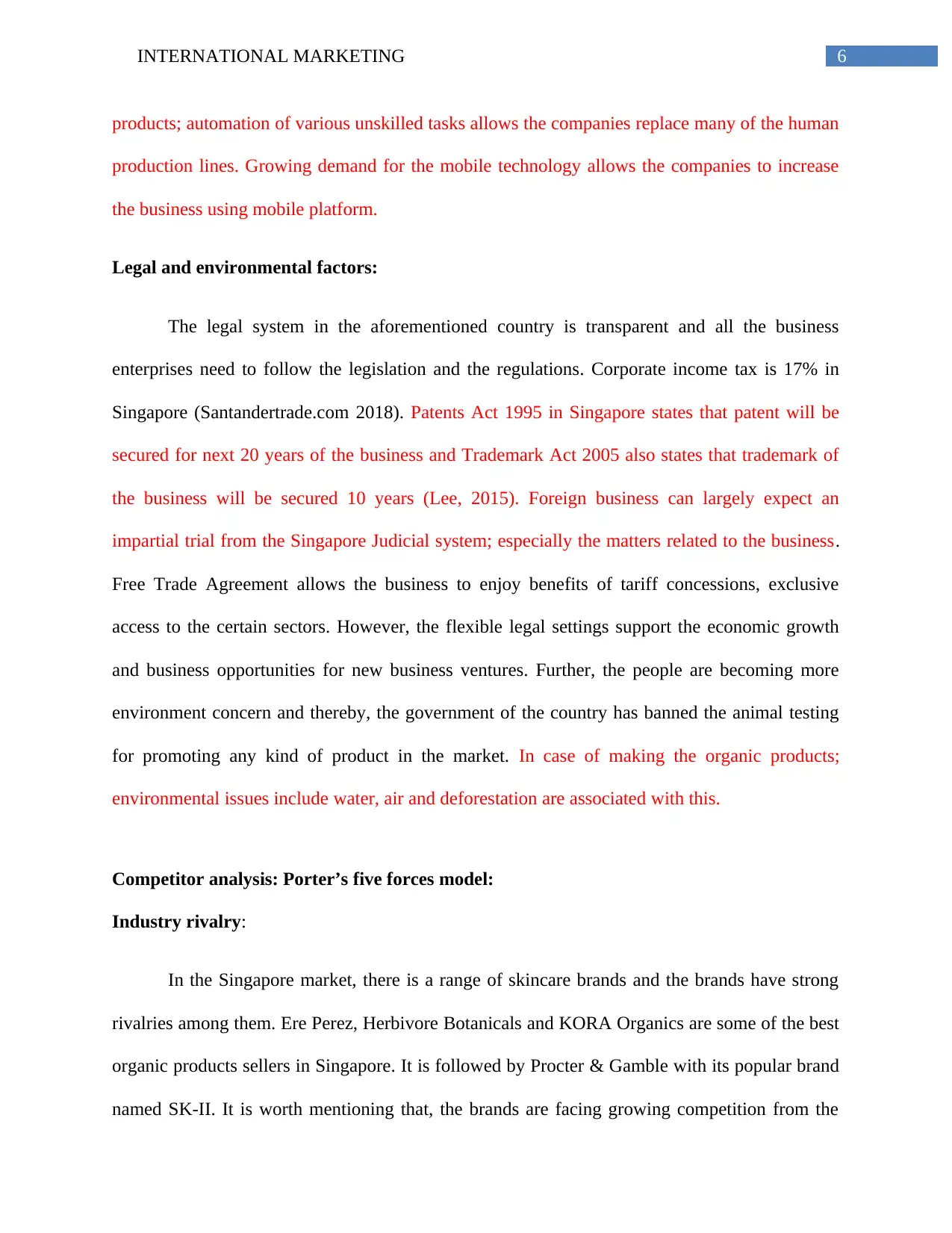
6INTERNATIONAL MARKETING
products; automation of various unskilled tasks allows the companies replace many of the human
production lines. Growing demand for the mobile technology allows the companies to increase
the business using mobile platform.
Legal and environmental factors:
The legal system in the aforementioned country is transparent and all the business
enterprises need to follow the legislation and the regulations. Corporate income tax is 17% in
Singapore (Santandertrade.com 2018). Patents Act 1995 in Singapore states that patent will be
secured for next 20 years of the business and Trademark Act 2005 also states that trademark of
the business will be secured 10 years (Lee, 2015). Foreign business can largely expect an
impartial trial from the Singapore Judicial system; especially the matters related to the business.
Free Trade Agreement allows the business to enjoy benefits of tariff concessions, exclusive
access to the certain sectors. However, the flexible legal settings support the economic growth
and business opportunities for new business ventures. Further, the people are becoming more
environment concern and thereby, the government of the country has banned the animal testing
for promoting any kind of product in the market. In case of making the organic products;
environmental issues include water, air and deforestation are associated with this.
Competitor analysis: Porter’s five forces model:
Industry rivalry:
In the Singapore market, there is a range of skincare brands and the brands have strong
rivalries among them. Ere Perez, Herbivore Botanicals and KORA Organics are some of the best
organic products sellers in Singapore. It is followed by Procter & Gamble with its popular brand
named SK-II. It is worth mentioning that, the brands are facing growing competition from the
products; automation of various unskilled tasks allows the companies replace many of the human
production lines. Growing demand for the mobile technology allows the companies to increase
the business using mobile platform.
Legal and environmental factors:
The legal system in the aforementioned country is transparent and all the business
enterprises need to follow the legislation and the regulations. Corporate income tax is 17% in
Singapore (Santandertrade.com 2018). Patents Act 1995 in Singapore states that patent will be
secured for next 20 years of the business and Trademark Act 2005 also states that trademark of
the business will be secured 10 years (Lee, 2015). Foreign business can largely expect an
impartial trial from the Singapore Judicial system; especially the matters related to the business.
Free Trade Agreement allows the business to enjoy benefits of tariff concessions, exclusive
access to the certain sectors. However, the flexible legal settings support the economic growth
and business opportunities for new business ventures. Further, the people are becoming more
environment concern and thereby, the government of the country has banned the animal testing
for promoting any kind of product in the market. In case of making the organic products;
environmental issues include water, air and deforestation are associated with this.
Competitor analysis: Porter’s five forces model:
Industry rivalry:
In the Singapore market, there is a range of skincare brands and the brands have strong
rivalries among them. Ere Perez, Herbivore Botanicals and KORA Organics are some of the best
organic products sellers in Singapore. It is followed by Procter & Gamble with its popular brand
named SK-II. It is worth mentioning that, the brands are facing growing competition from the
Paraphrase This Document
Need a fresh take? Get an instant paraphrase of this document with our AI Paraphraser
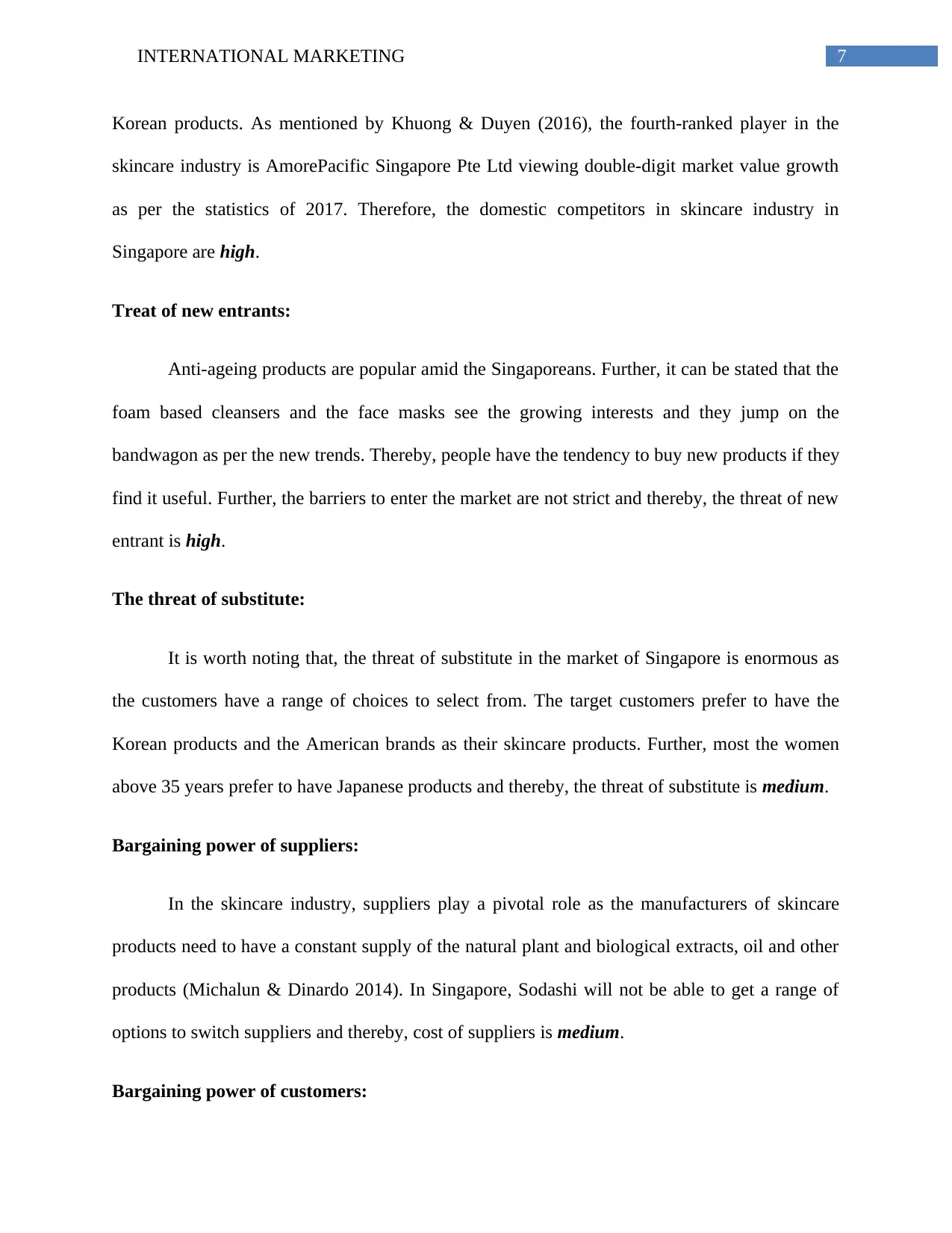
7INTERNATIONAL MARKETING
Korean products. As mentioned by Khuong & Duyen (2016), the fourth-ranked player in the
skincare industry is AmorePacific Singapore Pte Ltd viewing double-digit market value growth
as per the statistics of 2017. Therefore, the domestic competitors in skincare industry in
Singapore are high.
Treat of new entrants:
Anti-ageing products are popular amid the Singaporeans. Further, it can be stated that the
foam based cleansers and the face masks see the growing interests and they jump on the
bandwagon as per the new trends. Thereby, people have the tendency to buy new products if they
find it useful. Further, the barriers to enter the market are not strict and thereby, the threat of new
entrant is high.
The threat of substitute:
It is worth noting that, the threat of substitute in the market of Singapore is enormous as
the customers have a range of choices to select from. The target customers prefer to have the
Korean products and the American brands as their skincare products. Further, most the women
above 35 years prefer to have Japanese products and thereby, the threat of substitute is medium.
Bargaining power of suppliers:
In the skincare industry, suppliers play a pivotal role as the manufacturers of skincare
products need to have a constant supply of the natural plant and biological extracts, oil and other
products (Michalun & Dinardo 2014). In Singapore, Sodashi will not be able to get a range of
options to switch suppliers and thereby, cost of suppliers is medium.
Bargaining power of customers:
Korean products. As mentioned by Khuong & Duyen (2016), the fourth-ranked player in the
skincare industry is AmorePacific Singapore Pte Ltd viewing double-digit market value growth
as per the statistics of 2017. Therefore, the domestic competitors in skincare industry in
Singapore are high.
Treat of new entrants:
Anti-ageing products are popular amid the Singaporeans. Further, it can be stated that the
foam based cleansers and the face masks see the growing interests and they jump on the
bandwagon as per the new trends. Thereby, people have the tendency to buy new products if they
find it useful. Further, the barriers to enter the market are not strict and thereby, the threat of new
entrant is high.
The threat of substitute:
It is worth noting that, the threat of substitute in the market of Singapore is enormous as
the customers have a range of choices to select from. The target customers prefer to have the
Korean products and the American brands as their skincare products. Further, most the women
above 35 years prefer to have Japanese products and thereby, the threat of substitute is medium.
Bargaining power of suppliers:
In the skincare industry, suppliers play a pivotal role as the manufacturers of skincare
products need to have a constant supply of the natural plant and biological extracts, oil and other
products (Michalun & Dinardo 2014). In Singapore, Sodashi will not be able to get a range of
options to switch suppliers and thereby, cost of suppliers is medium.
Bargaining power of customers:
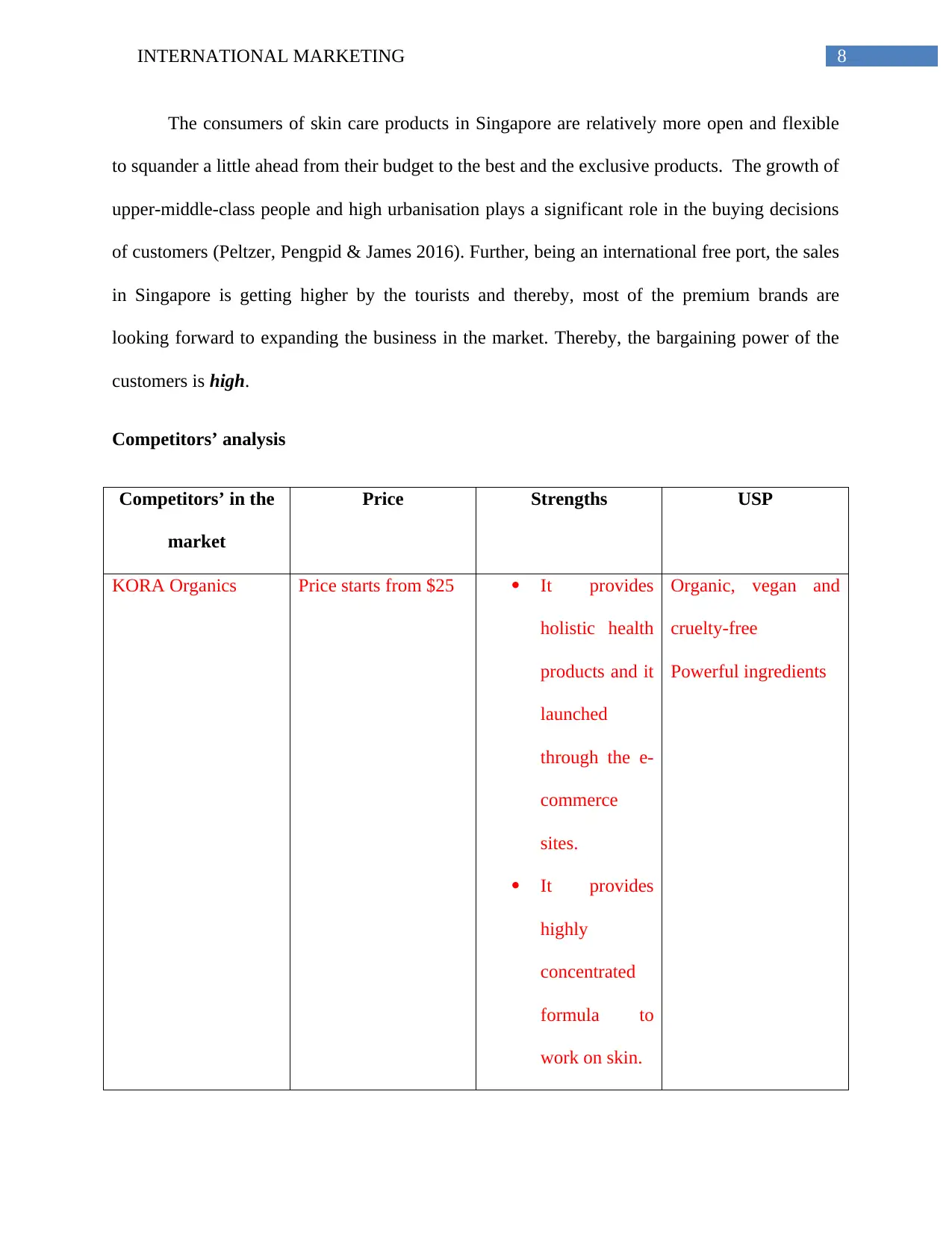
8INTERNATIONAL MARKETING
The consumers of skin care products in Singapore are relatively more open and flexible
to squander a little ahead from their budget to the best and the exclusive products. The growth of
upper-middle-class people and high urbanisation plays a significant role in the buying decisions
of customers (Peltzer, Pengpid & James 2016). Further, being an international free port, the sales
in Singapore is getting higher by the tourists and thereby, most of the premium brands are
looking forward to expanding the business in the market. Thereby, the bargaining power of the
customers is high.
Competitors’ analysis
Competitors’ in the
market
Price Strengths USP
KORA Organics Price starts from $25 It provides
holistic health
products and it
launched
through the e-
commerce
sites.
It provides
highly
concentrated
formula to
work on skin.
Organic, vegan and
cruelty-free
Powerful ingredients
The consumers of skin care products in Singapore are relatively more open and flexible
to squander a little ahead from their budget to the best and the exclusive products. The growth of
upper-middle-class people and high urbanisation plays a significant role in the buying decisions
of customers (Peltzer, Pengpid & James 2016). Further, being an international free port, the sales
in Singapore is getting higher by the tourists and thereby, most of the premium brands are
looking forward to expanding the business in the market. Thereby, the bargaining power of the
customers is high.
Competitors’ analysis
Competitors’ in the
market
Price Strengths USP
KORA Organics Price starts from $25 It provides
holistic health
products and it
launched
through the e-
commerce
sites.
It provides
highly
concentrated
formula to
work on skin.
Organic, vegan and
cruelty-free
Powerful ingredients
⊘ This is a preview!⊘
Do you want full access?
Subscribe today to unlock all pages.

Trusted by 1+ million students worldwide
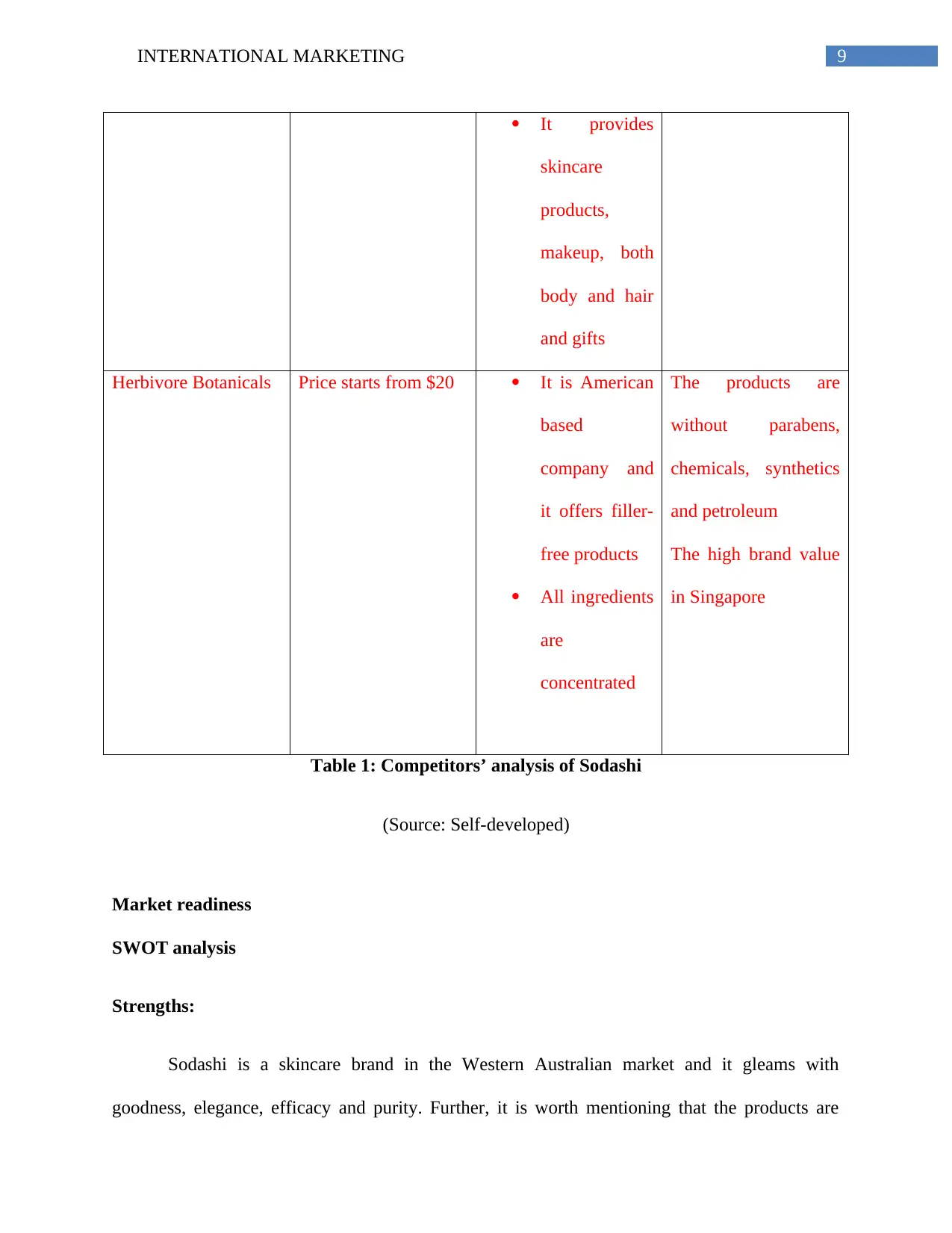
9INTERNATIONAL MARKETING
It provides
skincare
products,
makeup, both
body and hair
and gifts
Herbivore Botanicals Price starts from $20 It is American
based
company and
it offers filler-
free products
All ingredients
are
concentrated
The products are
without parabens,
chemicals, synthetics
and petroleum
The high brand value
in Singapore
Table 1: Competitors’ analysis of Sodashi
(Source: Self-developed)
Market readiness
SWOT analysis
Strengths:
Sodashi is a skincare brand in the Western Australian market and it gleams with
goodness, elegance, efficacy and purity. Further, it is worth mentioning that the products are
It provides
skincare
products,
makeup, both
body and hair
and gifts
Herbivore Botanicals Price starts from $20 It is American
based
company and
it offers filler-
free products
All ingredients
are
concentrated
The products are
without parabens,
chemicals, synthetics
and petroleum
The high brand value
in Singapore
Table 1: Competitors’ analysis of Sodashi
(Source: Self-developed)
Market readiness
SWOT analysis
Strengths:
Sodashi is a skincare brand in the Western Australian market and it gleams with
goodness, elegance, efficacy and purity. Further, it is worth mentioning that the products are
Paraphrase This Document
Need a fresh take? Get an instant paraphrase of this document with our AI Paraphraser
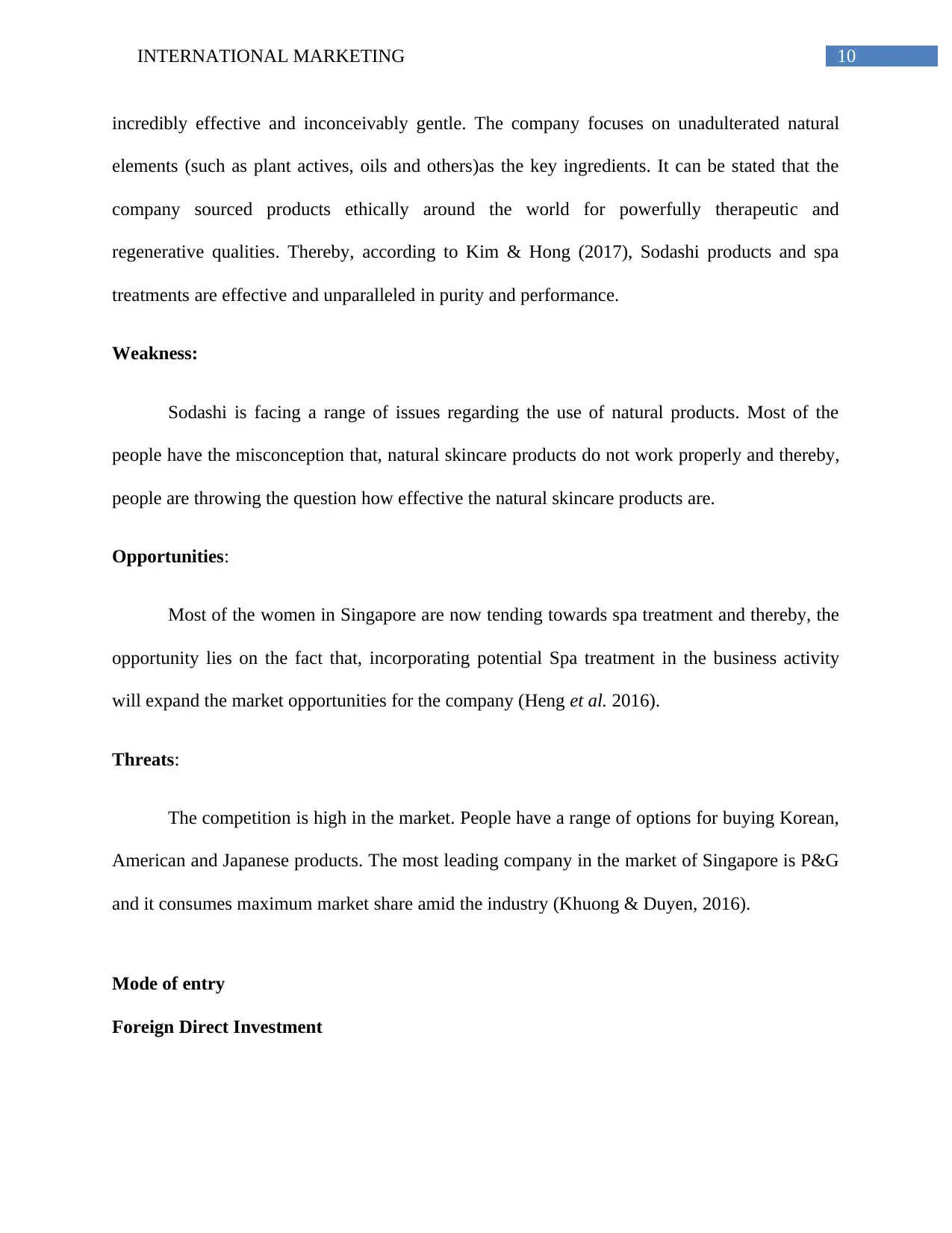
10INTERNATIONAL MARKETING
incredibly effective and inconceivably gentle. The company focuses on unadulterated natural
elements (such as plant actives, oils and others)as the key ingredients. It can be stated that the
company sourced products ethically around the world for powerfully therapeutic and
regenerative qualities. Thereby, according to Kim & Hong (2017), Sodashi products and spa
treatments are effective and unparalleled in purity and performance.
Weakness:
Sodashi is facing a range of issues regarding the use of natural products. Most of the
people have the misconception that, natural skincare products do not work properly and thereby,
people are throwing the question how effective the natural skincare products are.
Opportunities:
Most of the women in Singapore are now tending towards spa treatment and thereby, the
opportunity lies on the fact that, incorporating potential Spa treatment in the business activity
will expand the market opportunities for the company (Heng et al. 2016).
Threats:
The competition is high in the market. People have a range of options for buying Korean,
American and Japanese products. The most leading company in the market of Singapore is P&G
and it consumes maximum market share amid the industry (Khuong & Duyen, 2016).
Mode of entry
Foreign Direct Investment
incredibly effective and inconceivably gentle. The company focuses on unadulterated natural
elements (such as plant actives, oils and others)as the key ingredients. It can be stated that the
company sourced products ethically around the world for powerfully therapeutic and
regenerative qualities. Thereby, according to Kim & Hong (2017), Sodashi products and spa
treatments are effective and unparalleled in purity and performance.
Weakness:
Sodashi is facing a range of issues regarding the use of natural products. Most of the
people have the misconception that, natural skincare products do not work properly and thereby,
people are throwing the question how effective the natural skincare products are.
Opportunities:
Most of the women in Singapore are now tending towards spa treatment and thereby, the
opportunity lies on the fact that, incorporating potential Spa treatment in the business activity
will expand the market opportunities for the company (Heng et al. 2016).
Threats:
The competition is high in the market. People have a range of options for buying Korean,
American and Japanese products. The most leading company in the market of Singapore is P&G
and it consumes maximum market share amid the industry (Khuong & Duyen, 2016).
Mode of entry
Foreign Direct Investment

11INTERNATIONAL MARKETING
Foreign direct investment is the investment in form of controlling business ownership in
one country by the entity based in another country (Speckbacher, Neumann & Hoffmann, 2015).
For penetrating the international market, it is essential for the business enterprises to select
proper mode of entry by considering the degree of risks, commitment, control and ROI. From
this perspective, the concerned organisation Sodashi can take the strategy of Foreign Direct
Invest (FDI) by involving in investment for making the manufacturing centre at Singapore.
Establishing the manufacturing centre in Singapore will be easier to expand the business in
Singapore as Sodashi will control the ownership of the business and it will be direct control.
Further, the company can upgrade the skincare product making factory in the aforementioned
market without just outsourcing from Australia. With the help of this strategy, the Sodashi
becomes able to start the construction of the factory of developing a range of products so that, it
will be helpful for the company to sell fresh products to the consumers and the customer base
will be enhanced potentially.
It can be stated that the foreign direct investment in Singapore is easier and thereby, FDI
strategy will help the company to sell the products and service in the target market by avoiding
import duties and other taxes easily (Michalun & Dinardo, 2014). The foreign direct investment
in Singapore can be provided in a nutshell.
STPD Strategy
Segmentation
Segmentation approach Consumer characteristics Justification
Geographic Urban and suburban Sodashi will be able to
improve the customer base
Foreign direct investment is the investment in form of controlling business ownership in
one country by the entity based in another country (Speckbacher, Neumann & Hoffmann, 2015).
For penetrating the international market, it is essential for the business enterprises to select
proper mode of entry by considering the degree of risks, commitment, control and ROI. From
this perspective, the concerned organisation Sodashi can take the strategy of Foreign Direct
Invest (FDI) by involving in investment for making the manufacturing centre at Singapore.
Establishing the manufacturing centre in Singapore will be easier to expand the business in
Singapore as Sodashi will control the ownership of the business and it will be direct control.
Further, the company can upgrade the skincare product making factory in the aforementioned
market without just outsourcing from Australia. With the help of this strategy, the Sodashi
becomes able to start the construction of the factory of developing a range of products so that, it
will be helpful for the company to sell fresh products to the consumers and the customer base
will be enhanced potentially.
It can be stated that the foreign direct investment in Singapore is easier and thereby, FDI
strategy will help the company to sell the products and service in the target market by avoiding
import duties and other taxes easily (Michalun & Dinardo, 2014). The foreign direct investment
in Singapore can be provided in a nutshell.
STPD Strategy
Segmentation
Segmentation approach Consumer characteristics Justification
Geographic Urban and suburban Sodashi will be able to
improve the customer base
⊘ This is a preview!⊘
Do you want full access?
Subscribe today to unlock all pages.

Trusted by 1+ million students worldwide
1 out of 23
Related Documents
Your All-in-One AI-Powered Toolkit for Academic Success.
+13062052269
info@desklib.com
Available 24*7 on WhatsApp / Email
![[object Object]](/_next/static/media/star-bottom.7253800d.svg)
Unlock your academic potential
Copyright © 2020–2025 A2Z Services. All Rights Reserved. Developed and managed by ZUCOL.




